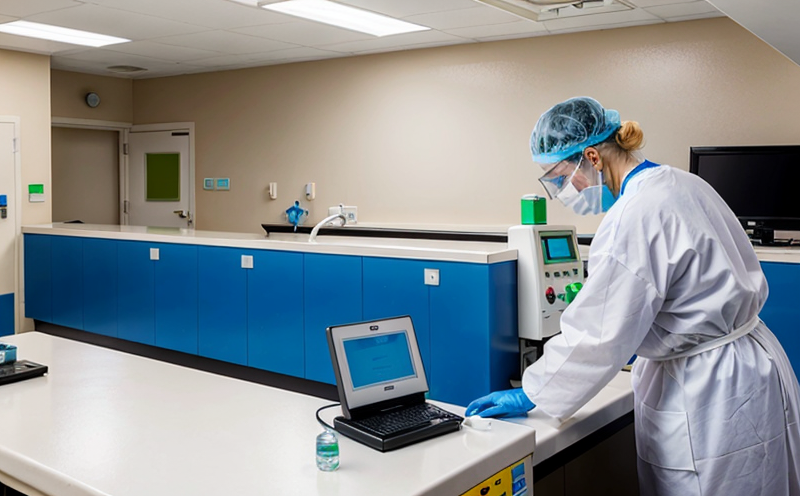Disinfectant Residue Testing on Medical Equipment
In clinical and healthcare environments, the use of disinfectants is critical for ensuring patient safety and preventing the spread of infections. However, the presence of disinfectant residues on medical equipment can pose risks if not properly managed. Disinfectant residue testing is a crucial process that ensures these residues are within safe limits to avoid potential harm.
The importance of this service cannot be overstated, especially in environments where patient care is paramount. By ensuring that disinfectants are used correctly and safely, healthcare providers can maintain the highest standards of hygiene and safety. This testing plays a vital role in compliance with international standards such as ISO 17654:2018 for medical device reprocessing.
Our laboratory employs advanced analytical techniques to conduct this testing. The process involves collecting samples from various pieces of equipment, including surgical instruments, endoscopes, and other high-contact devices used in patient care settings. Each sample is processed according to strict protocols designed to ensure accurate results.
The method we use for residue detection is based on quantitative analysis using validated methods like HPLC (High-Performance Liquid Chromatography) or GC (Gas Chromatography). These techniques allow us to measure the exact concentration of disinfectant residues present. The goal is not only to identify the presence but also quantify it, providing detailed reports that can help in making informed decisions.
The significance of this testing extends beyond mere compliance with regulations; it directly impacts patient safety and the overall effectiveness of healthcare practices. By ensuring that medical equipment remains free from excessive disinfectant residues, we contribute to reducing risks associated with cross-contamination and potential allergic reactions. This is especially important for patients who may have sensitivities or allergies.
Our service offers a comprehensive approach, incorporating not only the testing process but also expert advice on best practices for using disinfectants in healthcare settings. We work closely with our clients to understand their specific needs and provide tailored solutions that fit into their existing protocols. This includes recommendations on optimal usage times, storage conditions, and cleaning procedures.
In summary, disinfectant residue testing is an essential component of maintaining high standards of hygiene and safety in clinical environments. By leveraging advanced analytical techniques and providing expert guidance, we help healthcare facilities meet regulatory requirements while enhancing patient care.
Scope and Methodology
The scope of our disinfectant residue testing service includes a comprehensive evaluation of medical equipment for the presence and levels of disinfectants. This ensures that all surfaces come into contact with patients are safe from excessive residues which could potentially lead to adverse health effects.
Our methodology involves several key steps designed to ensure precision and accuracy. Initially, we collect samples from various types of medical devices such as surgical instruments, endoscopes, catheters, and other high-contact items used in patient care settings. These samples are then prepared according to our standard operating procedures which include cleaning them thoroughly before analysis.
Once prepared, the samples undergo quantitative analysis using validated methods like HPLC or GC. This allows us to measure the exact concentration of disinfectant residues present on each piece of equipment. The results from these analyses are then compared against established safety thresholds defined by relevant international standards such as ISO 17654:2018.
Our team of experts interprets these findings and provides detailed reports that include recommendations for optimal usage times, storage conditions, and cleaning procedures. These insights help healthcare facilities maintain the highest levels of hygiene and safety while ensuring compliance with regulatory requirements.
The entire process is designed to be meticulous and thorough, leaving no room for error or misinterpretation. By adhering strictly to international standards and employing cutting-edge technology in our analysis methods, we ensure that every test conducted meets the highest quality benchmarks.
Benefits
The benefits of conducting disinfectant residue testing on medical equipment are numerous and far-reaching. Primarily, it ensures patient safety by minimizing the risk of cross-contamination and infections within healthcare facilities. This is particularly important given the high volume of patients who pass through hospitals each year.
By keeping disinfectant residues at safe levels, we help prevent allergic reactions among sensitive individuals who might otherwise experience adverse effects from prolonged exposure to these chemicals. Additionally, this service supports compliance with international standards such as ISO 17654:2018 which mandates rigorous testing procedures for medical devices.
Our clients also benefit from enhanced operational efficiency since they can rely on accurate and reliable test results when making decisions about equipment usage times, storage conditions, and cleaning protocols. This leads to optimized resource utilization and reduced waste disposal costs associated with discarded contaminated items.
The peace of mind provided by knowing that your facility adheres to strict hygiene standards is invaluable. It reassures both staff members and patients alike that every effort has been made to create a safe environment free from unnecessary risks posed by disinfectant residues.
Industry Applications
The application of our disinfectant residue testing service spans across various sectors within the healthcare industry. Hospitals, clinics, and other medical facilities frequently engage us to ensure that their equipment meets stringent hygiene standards.
In surgical environments where precision is key, ensuring that instruments are free from residual disinfectants helps maintain operational efficiency without compromising patient safety. Similarly, in endoscopy suites where delicate internal procedures require sterilization between uses, accurate testing ensures compliance with best practices recommended by organizations like the Association for the Advancement of Medical Instrumentation (AAMI).
For long-term care facilities and rehabilitation centers dealing with vulnerable populations, maintaining a clean environment is crucial. Our services help these institutions adhere to guidelines set forth by governing bodies such as the Centers for Medicare & Medicaid Services (CMS) in the United States.
Additionally, our expertise extends beyond traditional hospital settings into emerging areas like telemedicine where proper sterilization of equipment used remotely becomes increasingly important. By providing reliable testing services tailored to these unique needs, we contribute significantly towards advancing innovation and quality within the healthcare sector.





